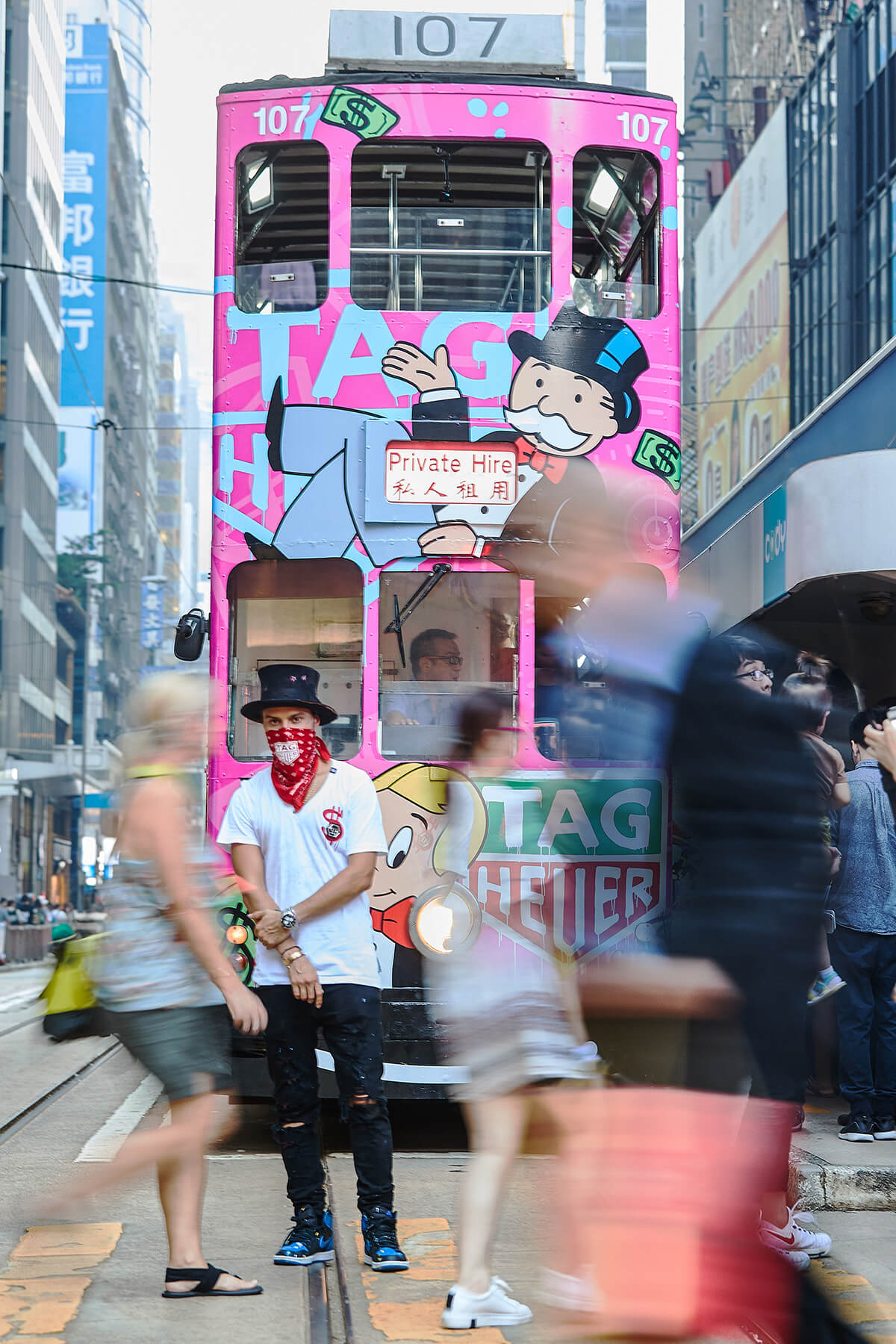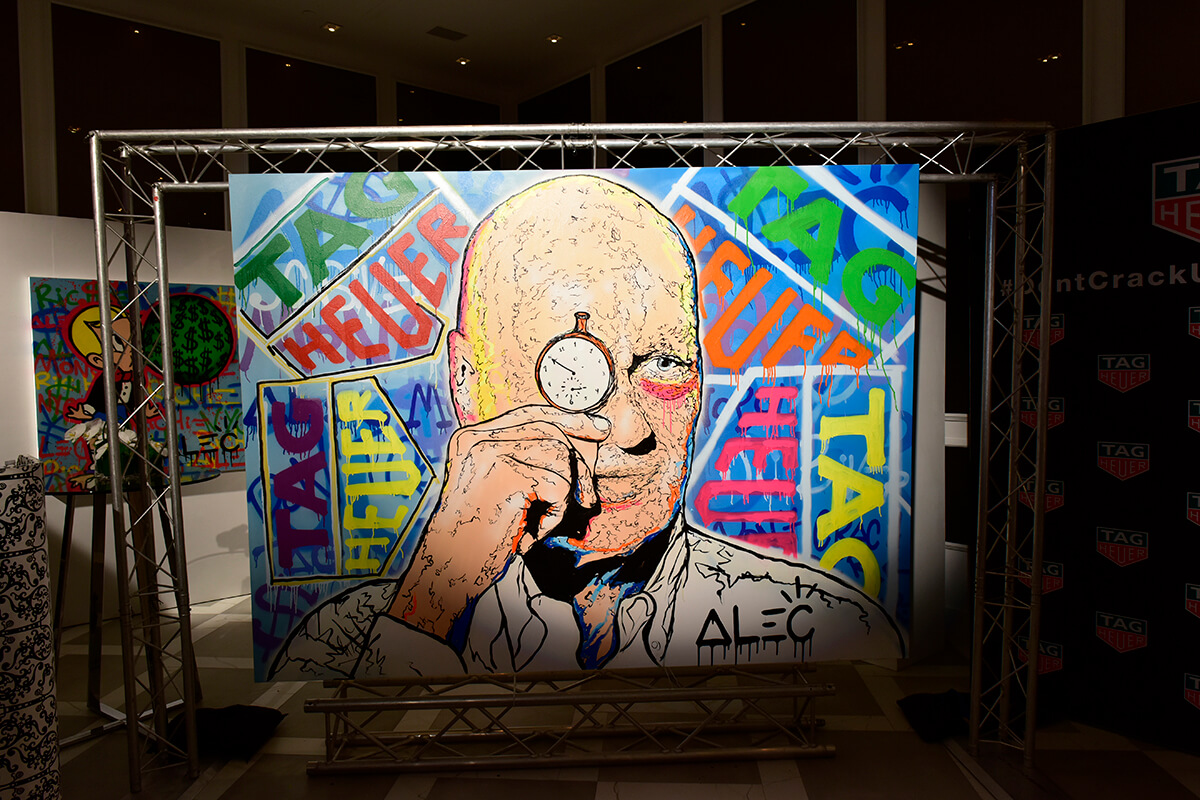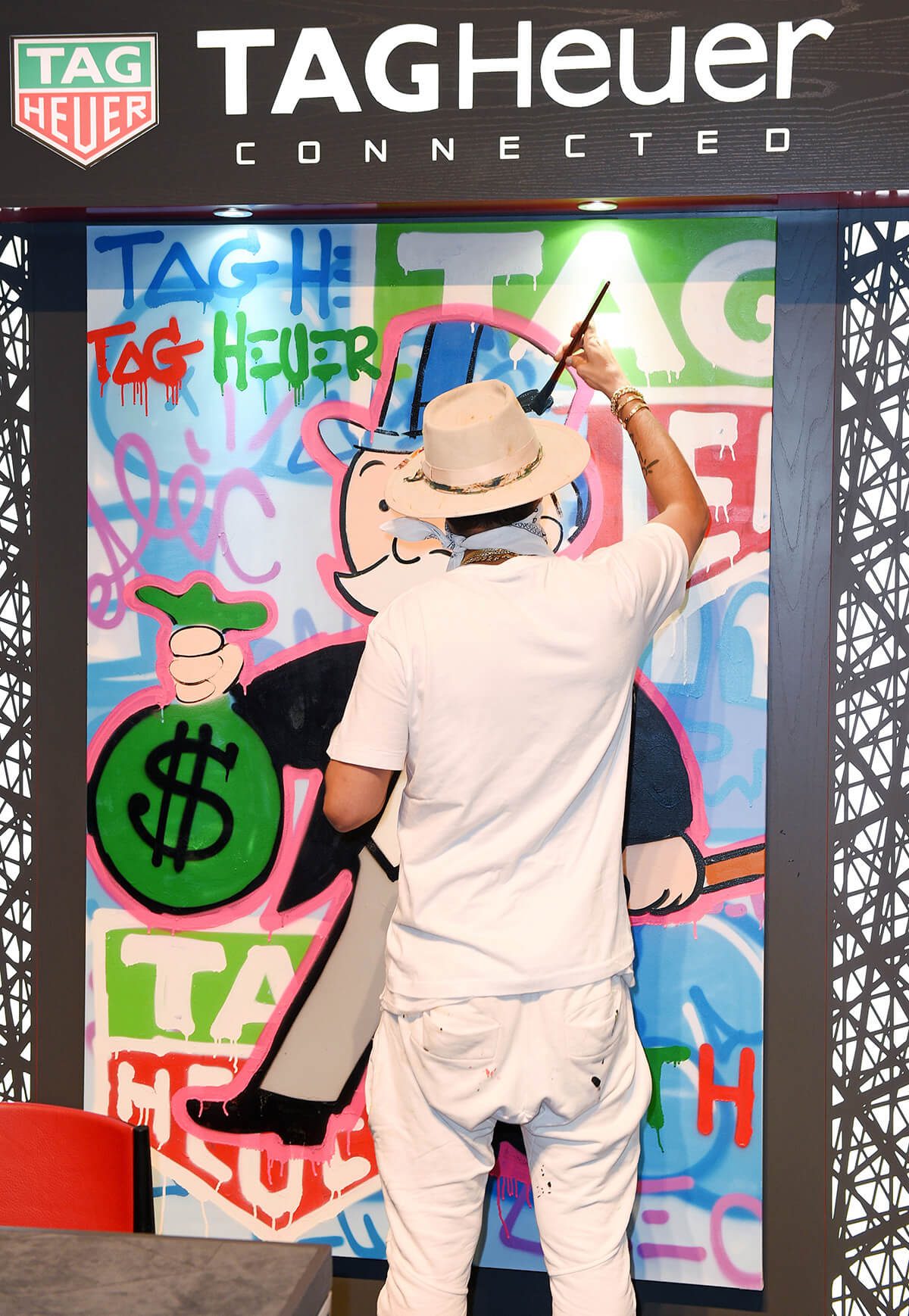
The artist in his signature (dis)guise in Hong Kong
Street artist Alec Monopoly’s distinctive creations are a blend of subversive graffiti culture and post-pop colour. And he has now been tasked with rejuvenating the culture at watch brand TAG Heuer. Nathalie Breitschwerdt catches up with the elusive – and anonymous – LA-based graffiti genius.
The manufacture of luxury watch brand TAG Heuer consists of a series of modern buildings on the edge of La Chaux-de-Fonds, in western Switzerland. The town is built on a US-style grid system, seemingly at odds with the rolling forested hills of the Jura that surround it.
Inside, it’s as you would expect a high-end watch factory to be. A sanitized workshop floor contains rows of technicians piecing together different watch components; other rooms contain test laboratories and machines for finishing the timepieces.
Walk from the workshop through some connecting corridors to the corporate offices, however, and you are greeted with an extraordinary sight. It is a glass-walled room with paints, canvases and strikingly colourful artworks, finished and in progress.
There was no artist at work on the day we visited – he was back in his home city of New York – but Alec Monopoly is no ordinary artist in-residence. Not long ago, his art was illegal. A graffiti artist, his trade involved tagging (painting) buildings – other people’s buildings – with his distinctive design. Monopoly developed a cult following on Instagram, and was then discovered by pioneering, maverick watch CEO Jean-Claude Biver. A key player in the revival of the luxury watch industry and now head of the LVMH watch division (which includes TAG Heuer), Biver made Monopoly a brand ambassador, launching the partnership at Art Basel Miami. Explaining why the artist would be given his own studio up in the Swiss mountains, Biver explained that Monopoly would play a key role in updating the brand for the new generation. “The most important thing is that Alec will be our art provocateur,” Biver said. “He will bring his influence inside the company. He will infuse the culture of TAG Heuer. That is the real job.”
Follow LUX on Instagram: the.official.lux.magazine
Monopoly’s real identity is still a secret: he hides his face behind a red bandana. But his post-Roy Lichtenstein takes on pop culture characters (and specifically the banker from the Monopoly board game) give him a universal and instantly recognisable appeal – as does his nuanced take on the world’s economic system.
Monopoly’s artworks are now appearing in TAG Heuer stores around the world, and he is more likely to be courted than taken to court by the property world now.

Alec Monopoly’s depiction of TAG Heuer ’s CEO Jean-Claude Biver at Art Basel Miami
LUX: When did you start making street art?
Alec Monopoly: I have been painting on the streets of New York since I was 12 years old. Growing up in the city, I loved skateboarding and the graffiti culture in the city. In 2008, I moved to Los Angeles and that’s when I started integrating my artwork into street art. I was a graffiti artist before and that’s when I became a street artist.
LUX: How has the perception of street art changed since you first started?
Alec Monopoly: It’s changed big time. It’s become more accepted into pop culture recently, whereas before it was much more frowned upon. In the early days especially, graffiti was looked on as pollution and destruction, but now it’s transforming the grey walls of cities into things of beauty. If you look at the Miami Design District and Wynwood, it’s changed a dangerous neighbourhood with abandoned buildings and actually turned it into something beautiful. Take a look at the Wynwood Walls where some of the best artists in the world come to paint; it’s a great example of how street art has been accepted into society.
Read more: Megan Balch & Jaime Barker, Founders of Flagpole on their inspirations and creative process
LUX: Tell us about your fascination with the Monopoly Man.
Alec Monopoly: I started painting the Monopoly Man in 2008 when the economy started to dip. I was playing the game Monopoly, which I love, and was watching the news where I saw Bernie Madoff being arrested. I remember thinking how ironic that situation was, as he sort of looked like the Monopoly Man. There was so much meaning to it. People really connect with the Monopoly Man, so that’s when I started painting him for fun in the street. Originally it was for fun, but it also became more real due to the situation. That’s when I started spreading more intricate characters into my paintings, like Robert De Niro, Twiggy and Jack Nicholson.

An Alec Monopoly creation in Miami’s Design District
LUX: Why do you think your artwork is in such high demand?
Alec Monopoly: People can really connect with my work. I create a lot of work that has a positive message; it’s fun and brings happiness to people. A lot of people have found that my work is inspirational. Having the Monopoly Man with bags of money and seeing him run with them, it’s kind of like a good luck charm, which you see in the offices of CEOs. Now, I draw a lot of inspiration from life: travelling, meeting new people, experiencing new things. I truly live through my artwork and express who I am as a character, as a person, through my paintings. I think it’s important for an artist to express themselves through their work in a way where people can see life through their eyes – my eyes.
LUX: Are there certain places in the world that are “street art hubs”?
Alec Monopoly: I would say there are different cities where street art is more popular. Berlin would be one of the top cities for emerging street artists and for street art in general because it’s more accepted into the culture there. I would say LA is great due to the massive walls throughout the city and then, of course, Miami Wynwood is the Mecca of street art, for now.

Alec Monopoly tags for TAG at a pop-up store in California
LUX: You’re a brand ambassador for TAG Heuer. How did that come about?
Alec Monopoly: It came about through an organic relationship with Mr Biver. We met in the south of France in my studio and created a relationship. I was really taken aback by him – he’s a genius. He’s like the Steve Jobs of the watch industry. Hearing him talk and his passion, we really connected as I have a great passion for watches myself. My dream has always been to create a watch with my artwork in the dial. We really saw eye to eye with the collaboration and it’s been an amazing journey for both of us. All the watches sold out immediately!
LUX: Is it strange for a street artist to be associated with a luxury brand or do you see it as a step in the right direction?
Alec Monopoly: I definitely think it’s a step in a positive direction. I’m very picky who I do brand collaborations with, but I think TAG is the perfect fit. It’s the perfect vehicle to pursue one of my dreams, which was to put my art inside a watch. I was very happy to do it.
Read more: Luxury in the treetops at Chewton Glen
LUX: Anonymity and graffiti seem to go hand-in-hand for street artists such as Banksy and yourself. Why is that important to you?
Alec Monopoly: For me, it represents the freedom to keep painting in the streets where I would like to paint. I paint in some places where it’s kind of a grey area with regards to the law, so it’s important to remain anonymous. It’s kind of fun too; I can take my hat, my mask and my jewellery off and no one really knows who I am – it’s kind of nice to have that double life. It’s very interesting that when I cover my face people recognise me and when I don’t, people have no idea who I am. It’s the weirdest thing!
LUX: How do you define art and its purpose?
Alec Monopoly: I see art as very important for culture. It’s a way of seeing what’s going on in that part of history and what’s going on in the world. For me, it’s a form of therapy and expression, but it also brings happiness to other people’s lives. When I’m painting one of these graffiti walls, I’m transforming that neighbourhood through bright colours. People driving by, kids growing up there – I try to bring them as much happiness as possible. I’ve met kids who started painting their own versions of the wall and creating their own art, which is really inspirational to me.
LUX: What do you do when not making art?
Alec Monopoly: Honestly, I’m always creating art. Yesterday I was at the beach and started making these drawings in the sand – I can’t even relax when I’m at the beach! I love art, it’s who I am.
View Alec Monopoly’s portfolio of work at alecmonopoly.com and Tag Heuer’s collections at tagheuer.com








